By Eva Everloo and Maya Schushan Orgad (Ph.D.)

As a FoodTech investor, PeakBridge is committed to exploring emerging food trends. Egg alternatives have been increasingly in the spotlight recently. Though relatively new compared to alternatives for dairy or meat, creating the perfect egg replacement has become the focus of a growing number of startups. Given the variety of market sub-segments and technological approaches within Alt. Egg, we decided to create this deep dive to help navigate the space. Egg alternatives are the third topic in the PeakBridge FoodTech deep dive series, after Mycelium and Alt. Fat. The biggest question in this post is: can egg alternatives be on par with eggs in terms of taste, texture, costs — and more?
THE BASICS
What are eggs? They are simply a hugely popular component of meals given the 1.3 trillion chicken eggs produced annually worldwide. Eggs are mostly commonly consumed boiled, poached, scrambled, or in an omelette These whole egg products are also called ‘egg-as-a-dish’. However, they do not make up the entire global egg market, worth $110bn in 2022. In fact, there is a USD $27bn market for egg protein as a B2B ingredient alone. Egg white protein makes up 60% of that market. (Figure 1). Interestingly, the global egg market is expected to grow to $160bn by 2027.
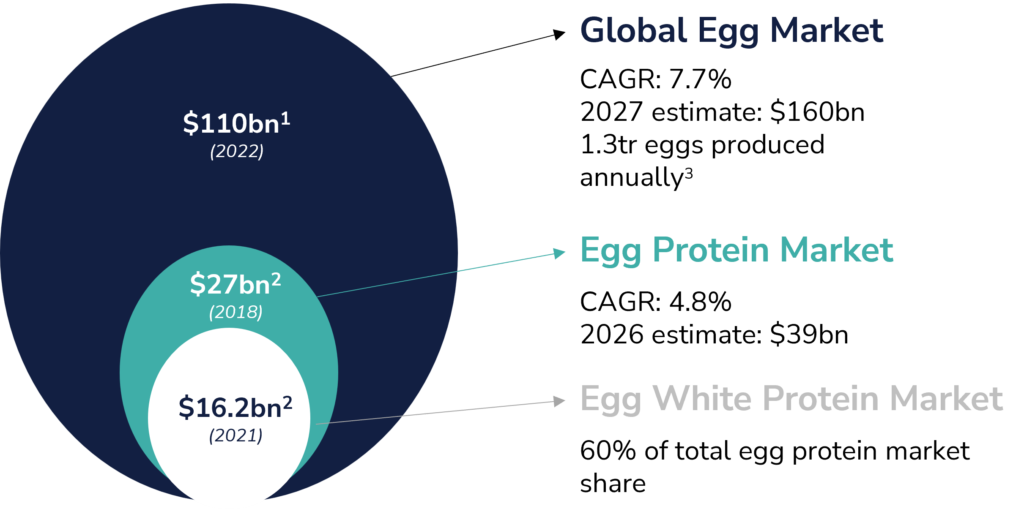
Given its essential role in food industry applications, this review focuses on egg white, used in various applications, including bakery, confectionery, desserts, sauces, fresh pasta, vegetarian meat replacements, and crab meat preparations.
What makes egg white so versatile a component of this wide range of food applications is its multifunctional properties. See Figure 2. It functions well as an emulsifier, thickener, gelling agent, foaming agent, and contains a good nutritional profile — high PDCAAS score and 85% protein by dry weight. Egg white is considered the golden standard for these functionalities. Hence, egg protein is usually the last ingredient to be omitted before a product becomes fully plant-based.

Four proteins account for most of egg white’s functionality: ovalbumin, conalbumin, and lysozyme. What do they do?
- Ovalbumin is responsible for stabilizing the gel structure
- Conalbumin is most heat-denaturable, meaning it breaks up the proteins upon heating
- Ovomucoid is the main allergen in egg white and imparts antimicrobial functionality
- Lysozyme has the highest solubility and functions as a preservative
Now that we have established the sunny side of eggs, let’s look at why egg alternatives are making their way onto the food scene.
THE RISE OF EGG ALTERNATIVES (THE “WHY”)
In the past few years, the egg industry has been in the spotlight for its negative environmental impact and animal welfare implications. Egg production is environmentally undesirable thanks to its significant greenhouse gas emissions such as, CO2, methane, and ammonia. The carbon footprint of a dozen of eggs is around 2.7 CO2eq. On top of that, intensive egg production facilities contribute to water and air pollution in the surrounding environment.
Since laying hens are often confined to small cages their welfare is virtually non-existent. Furthermore, an astounding 7 billion cockerels are culled yearly as they are simply an unwanted by-product of an efficient industry.
All of this drives consumer and food industry interest in plant-based (vegan) alternatives.
Other drivers for the rise of egg alternatives are food safety concerns with Salmonella, the high prevalence of egg allergies, the presence of cholesterol (linked to increased LDL-cholesterol and risk for chronic diseases), as well as the price volatility of eggs. This has stimulated market growth for egg alternatives, valued at USD $1.4bn, of which 80% is for egg white alternatives.
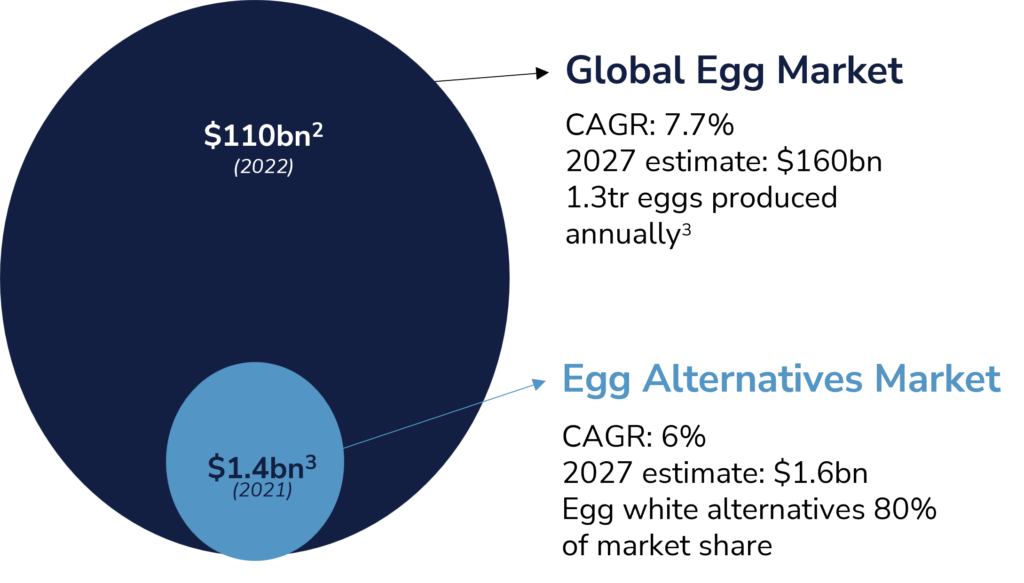
HOW IS THE MARKET SHAPING UP?
Egg alternatives (commonly also referred to as Alt. Eggs) aim to replicate the qualities of eggs in delivering a satisfying consumer experience. The expectations for egg alternatives are high: they need to bind, gel, foam, thicken, scramble, and boil like egg — ideally, do all the above.
The egg alternatives market consists of different sub-segments. In our review, we have distinguished egg white alternatives and egg-as-a-dish alternatives. Egg white alternatives are typically sold B2B as single ingredients or ingredient blends. Egg-as-a-dish alternatives mimic whole egg products and are typically sold B2C (see Figure 4). In both categories, startups have enabled rapid innovation in the past few years, using novel ingredients and approaches to mimic the functionalities of egg even better.
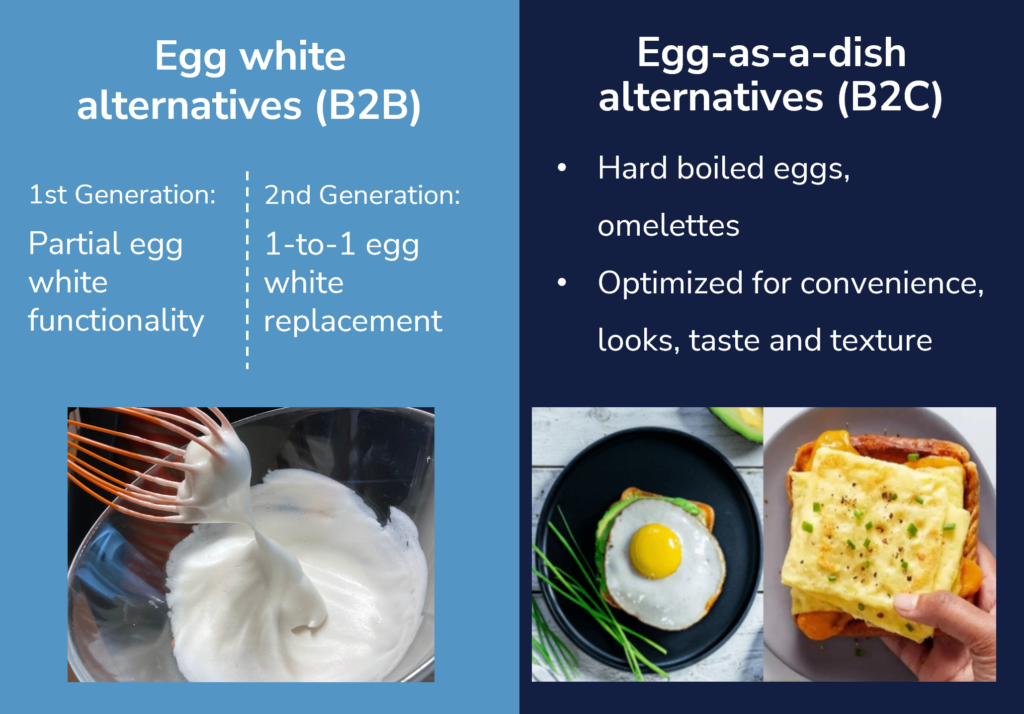
Let us dive deeper into egg white alternatives. Before this new wave of startups came along, egg replacement solutions were brought to market mainly by the large food ingredient players, which we refer to as the “first-generation egg white alternatives.” For example, consider ingredients like gums, potato starch, methylcellulose, and soy protein isolate. See Figure 5 for a more comprehensive list of ingredients that are typically used as egg white replacers in the food industry to date.

Due to the complex behaviour of egg white, however, not one of these ingredients sufficiently replaces egg white fully. Typically, a combination of these ingredients is required to complement functionality and reduce off-flavours (e.g., cellulose fibres + gums + potato protein). Such blends are created by what we refer to as “second-generation egg white alternatives”, offered mainly by startups. We will get to that later on.
But first — how do these first-generation alternatives compare to the state-of-the-art egg? While egg white has the drawbacks of a high environmental footprint, ethical burden, food safety issues, and price volatility, it remains the golden standard for functionality and nutritional profile in various food applications.
Alternatively, first-generation alternatives may have a lower environmental impact, good nutritional profile, long shelf life, and little food safety risk, the partial functionality and slight off-flavours, generally high price, and lack of clean label formulation make them far from ideal egg white replacers (Figure 6).
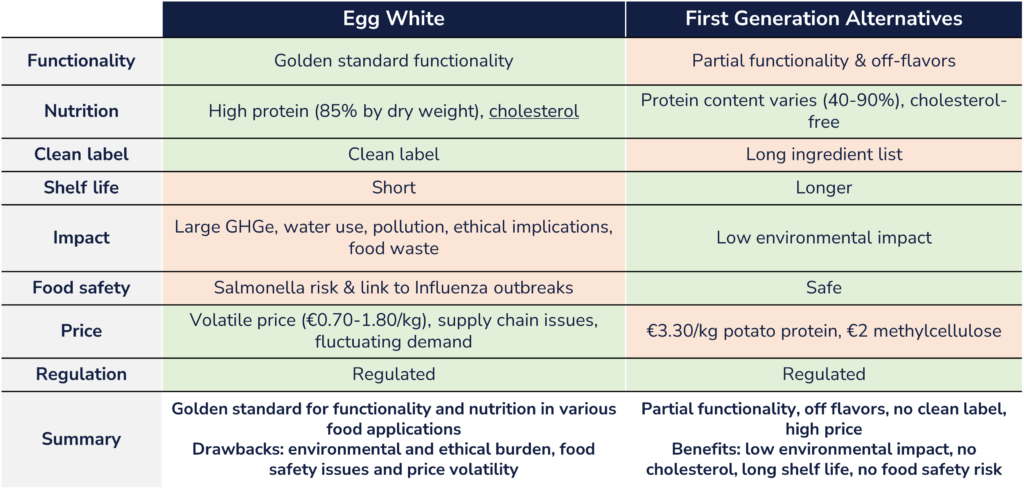
First-generation egg white alternatives do not yet satisfy consumer and food industry demand. Fortunately, a group of startups is emerging that is developing the new or second generation of egg white alternatives that seem to have found solutions for some of the issues listed above.
HOW ARE THE NEW EGG ALTERNATIVES CREATED? (THE “HOW”)
Three technological approaches are being relied on for the production of the new generation egg alternatives: plant-based, microbe-derived and precision fermentation. Each has its own benefits and challenges.
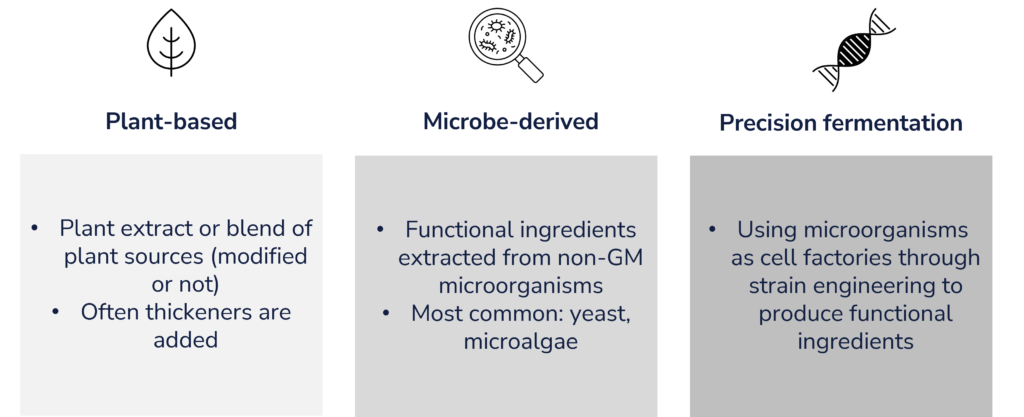
Plant-based approaches are typically a combination of plant extract (blends) and additives such as thickeners, such as, fibres and gums. This process is generally simple, as few technological steps are needed. The regulatory process is easy for plant-based approaches as their ingredients are already approved for human consumption. The upside is that products are low-cost -with a few exceptions- and easily scalable. The downside is the limited functionality (often: off flavour, low protein) and the lack of clean label.
Microbe-derived ingredients typically have better functionality than plant-based ones, but they also come at a slightly higher price. The regulatory process depends on the micro-organism strain and will be easy for companies working on ones that are already approved such as certain yeast strains and certain microalgae strains like Chlorella Vulgaris. On the other hand, novel micro-organisms might have functional, or cost benefits compared to those already known and used, making it worthwhile to go through the regulation process. Besides the regulatory issue, key challenges for this approach are COGS and scalability.
In precision fermentation, a micro-organism is genetically engineered to produce the ingredient(s) of choice. Consequently, the end-product can be manipulated in great detail through strain engineering and purification downstream processes to extract the desired novel ingredient. Key advantages of precision fermentation are the ability to have full control in tailoring to taste, texture, and other functionality profiles. Challenges include required know-how of genetic elements underlining the ingredient of choice, optimizing titres, regulatory hurdles, scalability, and COGS and currently limit precision fermentation startups to reach a competitive position.
How does this all fall into context? To answer that question, we have mapped the first- and second-generation egg white alternatives (and egg-as-a-dish) against the three main approaches in producing egg alternatives. Read the section below for these approaches (Figure 8). See also these excellent landscape reviews on alternative eggs by FoodHack and Trellis Road.
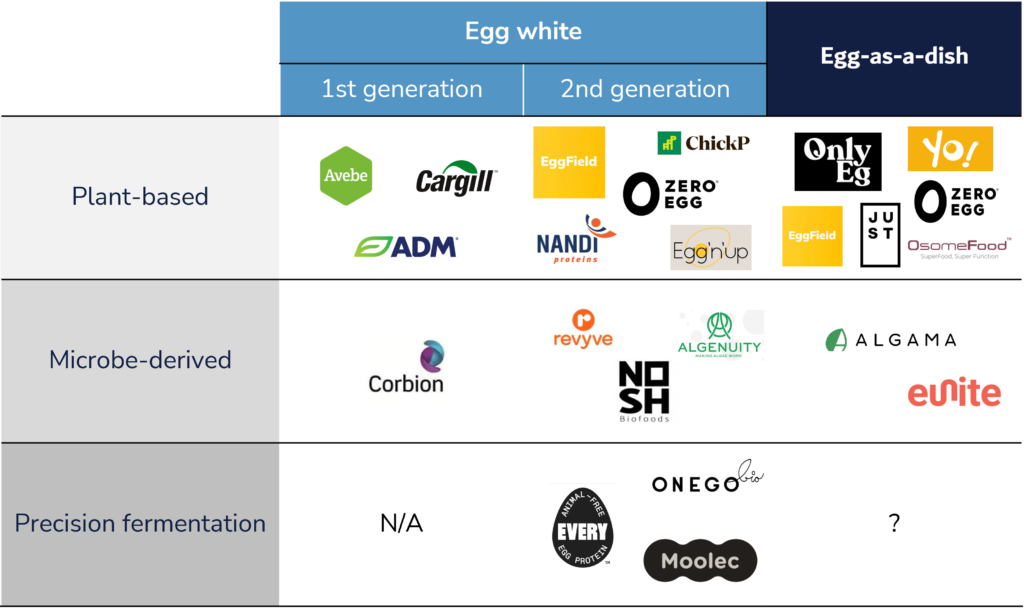
Wrapping up the analysis, we ranked each approach based on six key indicators for Alt. Egg white performance in Figure 9.
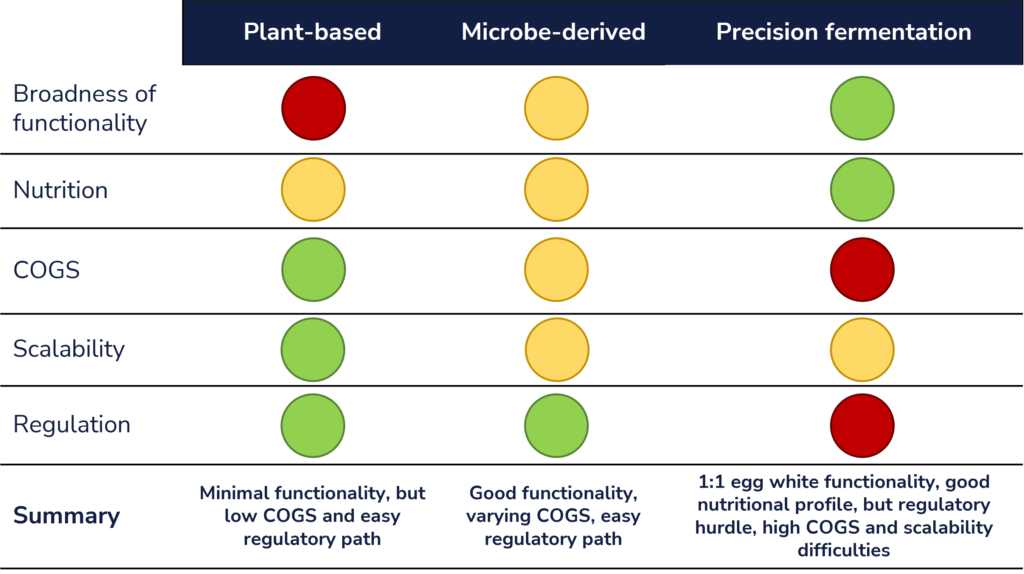
As seen in this figure, companies working on second-generation egg white alternatives all experience different opportunities and challenges. While this analysis is an approximation and remains a work in progress, we can draw general conclusions from the three different technological approaches.
KEY TAKEAWAYS
Egg white is considered the golden standard for emulsification, gelling, thickening, foaming, and more in a wide range of F&B applications. However, driven by sustainability concerns, ethical implications, health awareness and price volatility, consumers and the food industry are looking for functional replacers for egg. Three technological approaches for egg white alternatives present their own benefits and bottlenecks. Key performance indicators include the scope of functionality, COGS, scalability, and regulation.
This is an exciting, fast-moving space and a major opportunity to mimic the qualities of eggs cost-effectively while our favourite foods remain equally tasty, if not more so, with plant-based ingredients. That is how we scale positive impact.
FURTHER READING
– FoodHack: Cracked It: The 65+ Brands Hatching New Innovations In Plant-Based Eggs + Alt. Eggs Database
– Trellis Road: Cracking” into the Chicken-Free Egg Space + Alt. Egg Market Landscape (Excel)
– Good Food Institute: Plant-based egg alternatives: Optimizing for functional properties and applications
